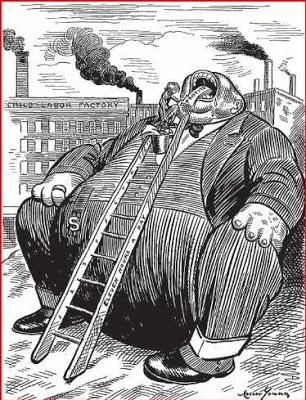 (The cartoon image of a greedy boss was drawn by Arthur Young in 1911.)
(The cartoon image of a greedy boss was drawn by Arthur Young in 1911.)It's bad enough that the wages of most American workers have been stagnant for decades now (while management and owners have grabbed most of the rise in productivity), and that too many workers still make at or near the minimum wage (which is far from a livable wage) -- but those are not all of the ways that employers abuse workers. Billions of dollars in labor and wages are stolen from workers each year by their bosses.
Following is part of an article by Bryce Covert on this issue at Think Progress:
. . . this kind of illegal behavior — wage theft — is more common than robberies. American employers are stealing from their workers at an alarming rate.
In the ten most populous states in the country, employers steal $8 billion a year from their employees simply by paying them less than the legally mandated minimum wage, according to a new report from the Economic Policy Institute (EPI). For the 2.4 million workers who are affected — 17 percent of the low-wage workforce — that amounts to an average loss of $64 a week. Given that they’re making just over $200 a week, on average, they miss out on nearly a quarter of their earnings. For someone working full-time under such conditions, he’ll lose $3,300 a year and bring home just $10,500 total — far below the poverty line. In fact, the report notes, wage theft is pushing a huge number of families into poverty. The poverty rate among workers who are illegally paid less than the minimum wage is over 21 percent, or three times the poverty rate for all minimum wage workers. If, instead, they were paid what they should be, a third would be lifted out of poverty and the rate would fall to under 15 percent. And even these staggering numbers are only a sliver of the problem. Given that the study looks at 10 states, which together represent 53 percent of all U.S. employment, the findings can be extrapolated to suggest that employers across the country steal a collective $15 billion from their employees each year. That figure exceeds the value of all property lost to burglaries, car theft, larceny, and robberies combined each year, which was less than $13 billion in 2015. Yet wage theft is not discussed very much. “It’s a much more abstract problem,” said David Cooper, senior economic analyst at EPI and an author of the new report. “When someone breaks into your home and steals your jewelry, you know it, it’s tangible, you can feel it right away. If your employer is doctoring your hours or asking you to work off the clock, folks in a lot of cases don’t recognize that that’s theft in the same way as someone breaking down your door and stealing goods from your home.” EPI’s figures also undercount the full extent of wage theft because they’re only focused on one type of illegal behavior: failing to pay employees the legally mandated minimum wage in their state. But wage theft generally encompasses any way that “employers are keeping money that workers are legally entitled to,” Cooper said: failing to pay overtime, pocketing tips, making employees work off the clock, denying them breaks, misclassifying them as exempt from minimum wage rules, and illegally deducting things from their pay. . . . It’s not an unsolvable problem. One deterrent would be ensuring that when wage thieves are caught, they have to pay. In most places, employers only have to pay a portion of back wages without any other penalty, thus ensuring that it’s cheaper to illegally underpay employees. “One very concrete solution,” Cooper pointed out, “is having strong penalties.” Some states have passed laws requiring treble damages, or awarding victims three times the value of what they were cheated. In those states, workers experience lower rates of wage theft. Workers also need more cops on the beat to make sure that employers are paying what they’re supposed to. At the federal level, the agency responsible for such policing, the Wage and Hour Division of the Department of Labor, employs about the same number of investigators as it did about 70 years ago, despite the workforce growing sixfold. In 1948 there was one investigator for every 22,600 workers; today it’s one for every 135,000. That’s led to a decrease in cases, which dropped by 63 percent between 1980 and 2015. Some states have their own robust departments to complement the Wage and Hour Division’s efforts. Others, however, have nothing at all. Florida, which had the highest rate of wage theft among all of the states EPI looked at, also has the fifth-weakest wage laws in the country and in 2002 eliminated its agency that investigated and enforced wage theft. “Unless you can make it really hurt for businesses to engage in this sort of behavior, in a lot of places the incentive is for them to screw their workers,” Cooper said, “because they’re probably never going to get caught, and if they get caught the worst that’s going to happen is they pay back wages.”

